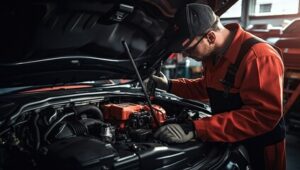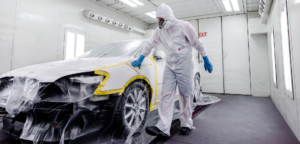Auto Repair in San Clemente focuses on preventive maintenance like oil changes, battery replacements, and fluid checks. This keeps vehicles running smoothly and extends their lifespan.

Other services include repairing electrical systems, replacing the transmission, and addressing issues with the steering or suspension. Choosing a shop with certifications and experience with multiple vehicle makes will make you feel confident in their work.
Many customers are reluctant to give a new auto repair shop their business, especially if they have been burned by previous shops. One way to build trust is by offering a free basic inspection. This allows the customer to get an idea of what work is needed, and gives them a chance to see the quality of work that you are capable of.
Another great auto repair marketing strategy is running promotions that feed into your loyalty program. This creates a steady pathway for people to go from first-time customers to lifelong ones. Just make sure you are careful with how much you discount your services, as discounts can hurt your profits if you don’t manage them well.
The best auto repair companies offer a variety of different services, including oil changes, air conditioning repairs, transmission replacements, and engine overhauls. Some companies are national chains, and others are independently owned. The national chains often have greater brand recognition and can inspire more trust, but they also tend to be more expensive.
Auto mechanics must have a great deal of mechanical knowledge in order to properly diagnose and repair cars. They need to know how each part of a car works, and they must be able to recognize any signs of damage or wear. The job can be physically demanding, and it can involve exposure to harmful chemicals and particulate dust. Mechanics must be comfortable working in confined spaces and wearing masks and gloves.
It is important for auto repair shops to keep up with the latest technology in automobiles. This is because the most current models often have advanced features that can cause problems for older cars. This is why it is so important for mechanics to be able to quickly and accurately diagnose any issues with the car. In addition, it is important for mechanics to be able to explain the repairs to their customers in a way that is easy for them to understand. Providing customers with a clear understanding of the problem and how it can be repaired can save both the customer and the mechanic time and money in the long run. This can be done by using the newest technology available, such as computerized diagnostics. These tools allow a mechanic to run tests and look at data without removing any parts.
Diagnostics
Getting your car repaired is a major investment, so you want to make sure it’s done right. Choosing a shop with high quality standards helps ensure your vehicle is safe and reliable. These standards include established repair techniques, manufacturer specifications, and regular inspections. In addition, certification programs can boost a shop’s credibility and trustworthiness. Other common quality control practices, such as effective communication strategies and process optimization, also help guarantee high-quality repairs.
A good auto repair shop will focus on identifying the root cause of the issue and repairing it effectively. They will also prioritize customer satisfaction and transparency throughout the repair process. This will prevent customers from feeling duped by inflating prices or unnecessary services.
In addition to implementing common quality control practices, an auto repair shop should have a team of skilled mechanics. Recruiting technicians with the right skills and experience can reduce repair time and costs. It is also important to conduct background checks and reference checks before hiring. ASE (Automotive Service Excellence) certifications can also improve a mechanic’s credibility and customer confidence.
Besides having an experienced and qualified team, an auto repair shop must also have the proper facilities. It is essential to have a large work area that can accommodate multiple vehicles at the same time. The space should also be well-lit and equipped with the latest tools and equipment. A mechanic should also have a dedicated area to store and manage their inventory of parts.
Another important factor is establishing business insurance. This is crucial to protect the business against damages or losses from theft and natural disasters. This type of insurance is available from many different providers. To find the best option, it is helpful to compare quotes from several companies.
Starting an auto repair shop can be a challenging task. However, by creating a detailed business plan, choosing the right business structure, and securing financing, you can set yourself up for success. Whether you need working capital to purchase equipment or pay for advertising, Lendio can provide the funding you need to turn your dream into reality.
Repair
Every car needs routine maintenance to keep it running in tip-top shape throughout its (hopefully) long life. Repairs are the other type of service, the unscheduled jobs like a flat tire or an infotainment system that keeps freezing up. Many auto repair shops offer the convenience of scheduling appointments online or over the phone to make it easier for customers to get their cars in and out quickly.
A good auto repair shop will provide a detailed estimate of the work to be done. The estimate should be broken down into sections for Customer and Vehicle Information, Parts, Labor, Miscellaneous Charges or Flat Fees, and a Summary of Charges. There should also be a section for how much time it is expected to take to do the work, which is called book time. The more specific the breakdown is, the better to avoid surprises at the end of the job.
Choosing a location is an important step when opening an auto repair shop. Look for a spot that has ample parking and is easily accessible to your target market. It should be large enough to fit multiple vehicles at a time, and it should have a comfortable waiting area for customers. It’s also essential that the location complies with zoning laws for auto repair businesses.
Consider the type of work you want to do and how it will impact your employees. For example, bodywork is physically challenging and exposes mechanics to fumes from paint and other chemicals. Mechanical repairs are less physically taxing, but they can be more tedious and require a greater knowledge of the inner workings of automobile engines.
The quality of service at an auto repair shop can be a big factor in a customer’s decision to return. It’s important for a business to have a clear plan for how it will maintain and grow its reputation. One way to do this is by offering an auto repair warranty, which helps build trust and encourages repeat business.
Some of these marketing strategies may be immediately actionable, while others may require more planning. However, all of them will help to drive more traffic to your auto repair shop. Creating engaging online content is a great place to start, and social media posts featuring testimonials from satisfied customers are always popular. Remember to ask customers for permission before posting their photos online, though. You should also set up a blog to share the latest news in the automotive industry and to answer frequently asked questions about the services your business provides. This is a great way to establish your expertise in the field and to attract new customers. Lastly, don’t forget to budget for unforeseen expenses. Equipment failure or slow periods can quickly drain your cash flow, so it’s important to have a contingency fund in place.

